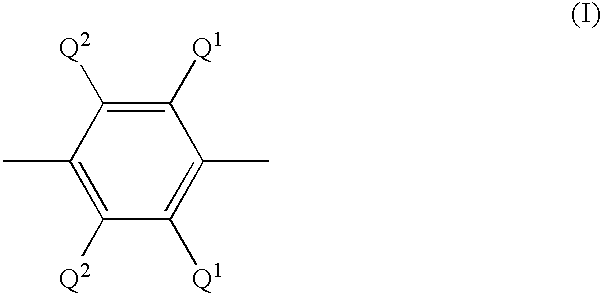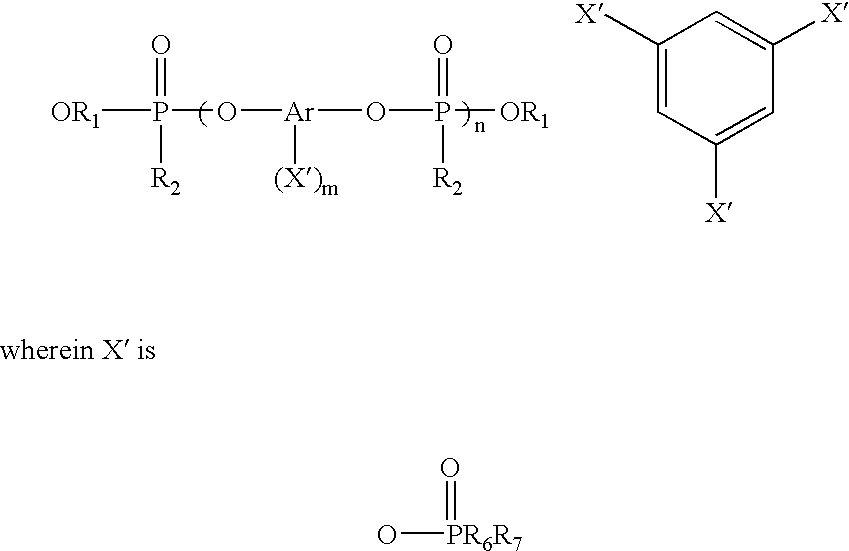High flow polyphenylene ether formulations with dendritic polymers
a technology of dendritic polymers and polyphenylene ether, which is applied in the field of polyphenylene ether formulations with improved properties, can solve the problems that poor melt flow can affect the size and type of parts, and achieve the effect of improving the flow properties of compositions
- Summary
- Abstract
- Description
- Claims
- Application Information
AI Technical Summary
Benefits of technology
Problems solved by technology
Method used
Image
Examples
examples 1-6
and CONTROL Y
[0063] Examples 1-6 and Control Y are set forth in Table 2. Control Y contains no flow modifier and Examples 1-6 employ BOLTRON H20 dendritic polymer as a flow modifier.
2TABLE 2 Formulation Y 1 2 3 4 5 .46 IV PPO resin 50 48 44 40 50 50 SBS, D1101 5 5 5 5 5 5 ZnS 0.1 0.1 0.1 0.1 0.1 0.1 ZnO 0.1 0.1 0.1 0.1 0.1 0.1 Nirez 2150 / 7042 Boltron H20 2 6 10 2 6 Boltron H30 PS, HIPS GEH 45 45 45 45 43 39 1897 HDT @ 264 psi 248 242 241 232 247 245 (1 / 8") .degree. F. Notched Izod. 73F 4.53 4.80 5.12 NO 4.40 5.60 ft-lb / in Total Energy, 73F 44.0 42.4 19.1 34.8 13.0 ft-lb Flexural Modulus, 347 342 320 292 336 323 73F (1 / 8") kpsi Flexural Str. @ 14,840 14,390 13,350 10,670 13,610 13,350 yield, 73F (1 / 8") psi Tensile Str. @ 8,460 8,100 7,520 5,810 7,990 8,150 yield, 73F 2 in / m / in, psi T. Strength @ 7,330 7,080 6,730 5,720 7,010 7,110 break 73F 2 in / m / in, psi T. Elongation @ 3.86 3.68 3.51 2.40 3.89 3.77 yield, 73F 2 in / m / in, % T. Elongation @ 26.8 30.4 25.1 9.6 33.3 36.4 break, 73F 2 in...
examples 7-10
[0064] Examples 7-10 are set forth in Table 3. Examples 7-10 employ BOLTRON H30 dendritic polymer as a flow modifier. [t3]
3TABLE 3 Formulation 7 8 9 10 .46 IV PPO resin 48 44 50 50 SBS, D1101 5 5 5 5 ZnS 0.1 0.1 0.1 0.1 ZnO 0.1 0.1 0.1 0.1 Boltron H30 2 6 2 6 PS, HIPS GEH 45 45 43 39 1897 HDT @ 264 psi 245 237 246 250 (1 / 8") .degree. F. Notched Izod, 73 F. 4.40 5.27 4.40 5.42 ft-lb / in Total Energy, 73 F. 31.3 14.9 29.2 18.1 ft-lb Flexural Modulus, 334 314 333 321 73 F. (1 / 8") kpsi Flexural Str. @ 14,140 12,990 14,270 13,700 yield, 73 F. (1 / 8") psi Tensile Str. @ 7,730 7,400 7,930 8,030 yield, 73 F. 2 in / m / in, psi T. Strength @ 6,880 6,680 6,960 7,000 break 73 F. 2 in / m / in, psi T. Elongation @ 3.53 3.35 3.83 3.84 yield, 73 F. 2 in / m / in, % T. Elongation @ 31.4 28.3 33.2 33.9 break, 73 F. 2 in / m / in, % Kayeness Rheology @ 300 C. Position, Pa-s Rate (1 / s) 100 741.9 280.8 803.3 293 500 334.9 94.7 365.8 111.2 1000 225.1 72.5 247.3 84.4 1500 175.7 65.1 193.8 74.7
[0065] A comparison of the d...
examples 11-22
, COMPARATIVE EXAMPLES G-F and CONTROLS Q and R
[0066] The compositions for Examples 11-22, Comparative examples G-L and Controls Q and R are set forth in Table 4. Examples 11-22 employ either BOLTRON H20 or BOLTRON H30 dendritic polymer as a flow modifier. Comparative examples G-L employ Nirez terpene phenol as an impact modifier and Controls Q and R do not contain any flow modifier.
4TABLE 4 FORMULATION Q G H I R J K L 11 12 .46 IV PPO 50.5 48.5 44.5 40.5 50.5 50.5 50.5 50.5 48.5 44.5 SBS, Kralon D1101 2.4 2.4 2.4 2.4 2.4 2.4 2.4 2.4 2.4 2.4 LLDPE 1.2 1.2 1.2 1.2 1.2 1.2 1.2 1.2 1.2 1.2 TDP 0.4 0.4 0.4 0.4 0.4 0.4 0.4 0.4 0.4 0.4 ZnS 0.1 0.1 0.1 0.1 0.1 0.1 0.1 0.1 0.1 0.1 ZnO 0.1 0.1 0.1 0.1 0.1 0.1 0.1 0.1 0.1 0.1 TSAN 0.2 0.2 0.2 0.2 0.2 0.2 0.2 0.2 0.2 0.2 Nirez 2150 / 7042 2 6 10 2 6 10 Boltron H20 2.0 8.0 Boltron H30 PS, HIPS GEH 28.5 28.5 28.5 28.5 28.5 26.5 22.6 18.5 28.5 28.5 1897 Liquid FR RDP 16.7 16.7 16.7 16.7 16.7 16.7 16.7 16.7 16.7 16.7 FR pump TOTAL PARTS 100.1 100.2 ...
PUM
| Property | Measurement | Unit |
|---|---|---|
| temperature | aaaaa | aaaaa |
| wt % | aaaaa | aaaaa |
| wt % | aaaaa | aaaaa |
Abstract
Description
Claims
Application Information
 Login to View More
Login to View More - R&D
- Intellectual Property
- Life Sciences
- Materials
- Tech Scout
- Unparalleled Data Quality
- Higher Quality Content
- 60% Fewer Hallucinations
Browse by: Latest US Patents, China's latest patents, Technical Efficacy Thesaurus, Application Domain, Technology Topic, Popular Technical Reports.
© 2025 PatSnap. All rights reserved.Legal|Privacy policy|Modern Slavery Act Transparency Statement|Sitemap|About US| Contact US: help@patsnap.com


